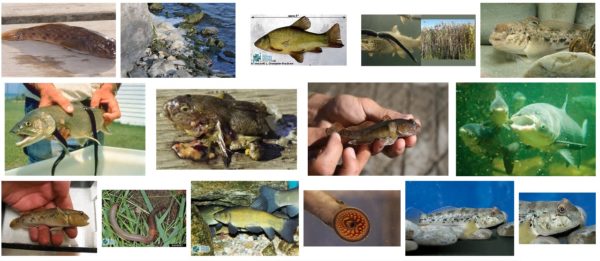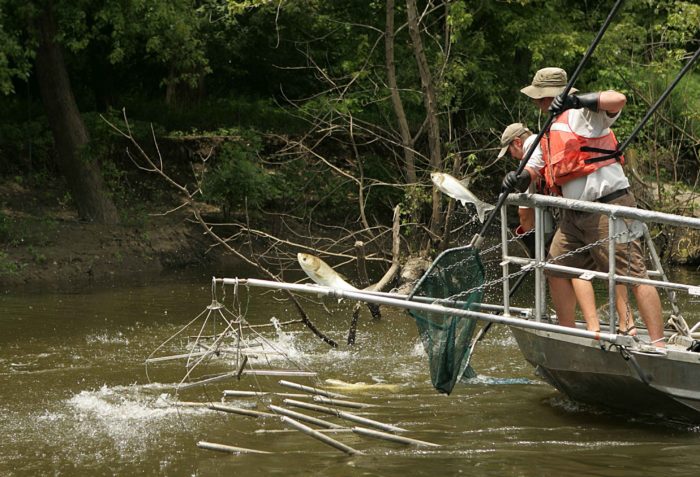No perch or pickerel in Lake Erie’s fisheries future? The tasty fish our Great Lakes are known for, and all other sport fish, could be decimated if the insidious Asian carp migrate from the Mississippi watershed.
Combined, the four Asian carp species could decimate the Great Lakes fishery by out competing our native fish.
Plankton, which is the base of the Great Lakes food chain, is consumed by silver and bighead carp. Grass carp prefer plants while black carp eat mollusks. Asian carp can consume up to 20 per cent of their weight every day.
Since escaping impounds near the mouth of the Mississippi River, the carp have spread north and are very near the Great Lakes in the Chicago Sanitary and Ship Canal. So far, everything from electric barriers to water-propulsion jets to noise cannons have been considered to keep them at bay.

But, the systems aren’t perfect. A silver carp was caught on June 22, just nine miles from Lake Michigan. Two weeks of intensive monitoring did not find any other carp. The captured fish has been sent for laboratory analysis to search for more clues on how it got there.
While some fear this is the beginning of the end, it should be noted that a bighead carp was also found in the area in 2010. The protocol for stepped-up monitoring wasn’t in place then, but no Asian carp have been found in the area in the ensuing seven years.
Most of the media attention rightfully is focused on the Chicago Sanitary and Ship Canal (zoom and scroll on the map above) as a route for the invasion, but it is not the only possible route. Silver carp have been found in the Ohio River and that state’s Little and Great Miami Rivers – all pathways to Lake Erie. Barriers have improved in Indiana’s Eagle Marsh, where, during flooding, there is a possibility carp could move from the Mississippi watershed to Lake Erie.
Although science and technology continue the search for solutions to the Asian carp threat, politics can get in the way. The Great Lakes states, with the exception of Illinois and Indiana, were in favor of blocking the Chicago Sanitary and Ship Canal. Perhaps the last president hailing from Chicago was a factor in this not happening.
While on holidays in Louisiana, I testified at Army Corps of Engineers hearings for their Great Lakes and Mississippi River Interbasin Study. I support chemical, electrical, vibration and other methods used to deter invasives moving up the Chicago canal.
The U.S. administration has stalled the release of their report, although two weeks ago, the U.S. Senate Appropriations Committee approved a bill that would force its release. The bill had support from both sides of the House.
Similarly, there has been bi-partisan support to block a move in the presidential budget that would slash the Great Lakes Restoration Initiative funding from $300 million to zero. A portion of that funding goes to Asian carp programs.
On the home front, I have pushed for legislation that Asian carp brought into Ontario for food must first be eviscerated.
Ontario has passed the Invasive Species Act, becoming the first province with legislation dedicated to addressing the threat. Asian carp are included in this law.
Much of the attention and expenditure on Asian carp has been south of the border. In my view, more could be done in Ontario. For the Silo, MPP Toby Barrett.
Featured image- Electrofishing for the invasive Asian carp (Photo By U.S. Fish and Wildlife Service [Public domain]
Supplemental- Is Asian Carp ‘invasion’ actually a secret ‘stocking initiative’ for bolstering commercial fishing? Published on 13 Aug 2013 Asian Carp Processing Plant- Kentucky -Two Rivers Fisheries in Wickliffe, KY is taking a run at the Asian Carp market. With an abundance of Bighead and Silver carp in nearby waterways, the fish market is set to process and sell these fish for consumption. Commercial fishermen have often said if you pay us for the invasive carp we will catch them and that is exactly what is happening in Western Kentucky.

Casting light on Ontario baitfish disease and invasives
Recreational fishing is a $1.7 billion economic driver in Ontario.
As such, the government is committed to supporting recreational fishing in Ontario.
The commercial bait industry has a lengthy history with 1,100 commercial bait lincenses issued each year and a value estimated at $23 million.
Some of Ontario’s popular fisheries – such as walleye, perch and lake trout –rely heavily on live bait. The majority of anglers – 60 to 80 per cent – use live baitfish and leeches at least some of the time. It’s prevalent during ice fishing season, in our local Inner Bay.
An estimated 4.2 million angling trips involving live bait take place each year in Ontario, with 25 per cent occurring over distances greater than 400 kilometres. A large portion of Ontario anglers live and purchase bait in the southern part of the province, where invasive species and diseases are most prevalent. This large-scale movement of bait increases the risk of spreading species and diseases to new parts of the province.
The management of Ontario’s bait resources is challenging, needless to say.
Ontario’s Sustainable Bait Management Strategy, announced last summer, is the result of extensive consultation with industry, stakeholders, the public and Indigenous communities. As Parliamentary Assistant to the Minister of Natural Resources, two years ago, I held hearings in Kenora, Thunder Bay, Sudbury, Kingston, Barrie and London.
The use of live bait can move invasive species and disease, but also result in movement of native species like Yellow Perch and Bass to waters where they do not occur naturally. This can disrupt fish community dynamics in the receiving waterbody, including the loss of native species such as Brook Trout.
The spread of invasive, non-target species and diseases may be facilitated through the movement of bait. For instance, live bait may be harvested from one area of the province, it is often shipped, sold and later used in another region.
Another factor is dumping. When anglers dump the contents of bait buckets in or within 30 metres of a watercourse, it’s illegal and risks spreading non-target species and diseases.
Many anglers harvest their own bait. Surveys have shown that 30 to 50 per cent of Ontario anglers who fish with live baitfish have harvested their own bait at some time.
This province’s final strategy will increase business certainty for the commercial bait industry and increase protection for Ontario’s fisheries.
As part of this new strategy, the government is establishing four Bait Management Zones (BMZ) to limit the movement of live bait across the province.
Anglers wishing to use live bait outside of the BMZ where they reside must purchase their bait from a licensed commercial bait operator in that BMZ, use the bait within two weeks of purchase, and keep the sales receipt as proof that the bait originated from that BMZ.
Also in the strategy, 34 species are eligible as bait. And we are restricting the use of and storage of bait in native Brook Trout lakes.
Finally, we are committed to working with stakeholders on many topics related to commercial bait fish licenses to develop a compliance framework and extend licence terms up to three years.
Our goal – protection for the benefit of all while supporting the province’s thriving sport industry.
Toby Barrett MPP for Haldimand-Norfolk
UPDATE- Working indoors at Queen’s Park for Onttario’s great outdoors
We are blessed with a diverse natural environment across Haldimand-Norfolk, and it’s
with mixed feelings I’m back in the big city to work indoors at Queen’s Park.
Like so many I represent, I enjoy working and playing outdoors. I’ve been fortunate
to work indoors in Toronto addressing the outdoors with my various assigned
positions over the years to the Ministries of Environment, Natural Resources, and
Agriculture.
Here’s a look at what I’ve been up to lately. Hard on the heels of Camo Day, and the
National Hunting, Trapping and Fishing Heritage Day, when the Legislature first
convened, I had an opportunity in the House to talk about trees and moose.
On the 100th Anniversary of National Forest Week, I explained to the House that
Ontario has more than 71 million hectares of diverse forest cover—that would be
175,444,821 acres —renowned internationally for being looked after in a sustainable
way.
Our forest sector employs 147,000 directly and indirectly, generating $18 billion
annually. Every year, almost 73 million trees are planted and over 200 million seeds
spread.
We want to ensure our fish and wildlife remain healthy and abundant—a difficult task
that requires vigilant oversight as circumstances are always changing. One of the
more challenging species to manage is the Canadian moose, which was my topic during
question period the first week back.
There are concerns about the moose draw system and its fairness. Some hunters have
been applying year after year for a tag but never received one. Minister of Natural
Resources and Forestry John Yakabuski explained in order to protect the population
of the species, we are proposing stricter calf tag quotas, new bow hunting seasons
and quotas for moose.
North America’s Great Lakes are important for native species and support thousands
of different plants and animals. However, these lakes are facing pollutants, excess
nutrients and invasive species. This generated a series of formal questions from me
to Environment Minister Jeff Yurek.
Some of the exciting news stemming from my questions is that the provincial and
federal governments released a draft of the new Canada-Ontario Agreement on Great
Lakes Water Quality and Ecosystem Health. Ontario is also investing up to $1.67
million for the new Great Lakes Local Action Fund, with up to $50,000 for projects
led by local groups.
Another recent question to Minister Yakabuski concerned Chronic Wasting Disease.
CWD is a progressive, fatal disease that affects members of the cervid family—deer,
elk, moose and caribou. CWD can upset the balance in an ecosystem and can ultimately
threaten the safety of our food supply.
Last December, our government announced a CWD prevention and response plan to ensure
approaches are in place to minimize the risk of the disease entering or spreading
within Ontario. Additionally, this summer we proposed to prohibit the import of
live, captive cervids from outside of the province.
Farming represents outdoor living. In September, Minister of Agriculture Ernie
Hardeman and I announced over $7.9 million in funding through the Canadian
Agricultural Partnership (CAP) to fund a variety of initiatives. Examples would be
planting over-wintering cover crops to improve soil health, reduce soil erosion
losses and prevent phosphorous from going into Lake Erie.
Although I much prefer to work in the riding, I am fortunate to work indoors at
Queen’s Park for the betterment of the great outdoors.
Toby Barrett MPP for Haldimand-Norfolk